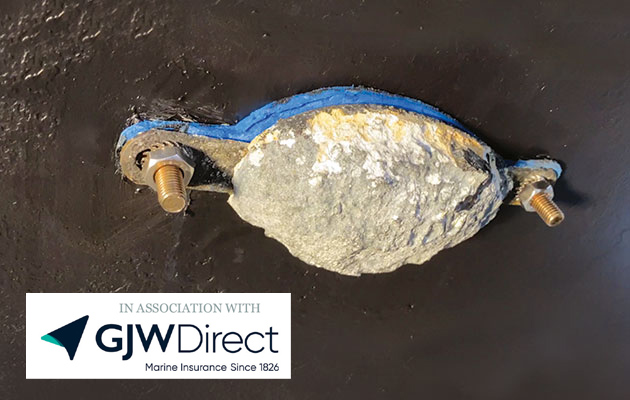How to deal with gelcoat chips and achieve a perfect colour matched surface. Bruce Jacobs finds out from Mark Buckett of Solent Repairs. IN ASSOCIATION WITH GJW DIRECT
From rope chafing on cockpit coamings to impact damage after a winch handle has been dropped, gelcoat chips are an inevitable result of any boat that has miles under its keel. Yet repairing them is not as hard as you might think. With a simple but methodical approach, surfaces can be easily restored which not only improves their appearance but can help the structure of the laminate beneath.
Like any cosmetic repair, achieving the best result is more about the preparation and process than it is about specific skills.

1 – Preparing the repair
First, it’s important to create a surface that will provide a good bond for the filler. Using a small burr on an electric drill work it around the damaged area. Next, lightly sand the area, this will provide a good key for the filler.

2 – Mixing the filler
Start with some white gelcoat filler and add some Cabosil, (a colloidal silica powder), to thicken up the mixture to around the consistency of peanut butter. This will allow you to use the substance as a filler and will keep it in place during the cure. Then, carefully add the catalyst and mix thoroughly again. The amount of catalyst required will vary depending on the surrounding temperature so make sure you have checked with the manufacturer’s instructions.

3 – Applying the filler
Using a plastic spatula gently apply the filler over the damaged area. You will need to make a few light passes over the area to ensure that the filler is fully located and is flush with the surrounding surface. Don’t put too much pressure on the spatula as this will drag the filler out of the surface hollow.
The filler will shrink slightly as it cures but when you apply the gelcoat later, this should build the repair back up so that is flush once again with the surrounding area.
Tip – don’t leave the cup of mixed resin on the deck in case it exotherms. If it does, the heat generated may mark the deck. If the resin does exotherm, you will no longer be able to use it for the repair and simply add a little water to cool it down to make it safe.

Article continues below…
How to: check and change an anode
Promotional feature in association with GJW Direct. Keeping your anodes in good order prevents serious damage on board, says Rubicon…
How to: troubleshoot your diesel engine electrics
Promotional feature in association with GJW Direct. If you're engine won't start, knowing how to find the source of the…
How to repair a sail – video guide
Knowing how to patch up a sail can get you home safely, extend your cruise and save you money. Rob…
4 – Rubbing down the filler
For typical gel coat chips wait around 30mins for the filler to cure before attempting to sand the surface down. When you do, the grades to use are 120, 320 and then 800. Use a block when sanding to make sure that the surface is even and that you don’t introduce a hollow.

5 – Colour matching
Taking liquid gelcoat the first stage is to match the colour. This process requires patience and a step by step approach to get the best results. Yellow and black are the most common pigment colours that are used when matching white gelcoat.
Add a tiny dot of pigment, often it’s about a pin head sized drop and mix thoroughly. Then paint a small amount alongside the repaired surface and judge how close the match is. You will most likely need to go through this process a few times to get the colour right, don’t rush it.

6 – Applying gelcoat
When you think you’re there with the colour, add the catalyst, mix thoroughly and apply to the repair. You will need to apply a number of coats, usually around 3-5 leaving 15-20mins between each application. If you can run your finger over it without picking up any of the gelcoat the surface is ready for another application.
Leave for at least 24 hours before then lightly rubbing down using a light 800 grade paper. Then using rubbing compound bring up to a final finish.

In association with GJW Direct
GJW Direct offers some of the most comprehensive and competitive boat insurance policies on the market. With more than 175 years in marine insurance, when you insure your yacht with us, you’re dealing with the boat insurance specialists, leaving you free to enjoy your time on the water. For more information, visit: www.gjwdirect.com

For all the latest from the sailing world, follow our social media channels Facebook, Twitter and Instagram.
Have you thought about taking out a subscription to Yachting Monthly magazine?
Subscriptions are available in both print and digital editions through our official online shop Magazines Direct and all postage and delivery costs are included.
- Yachting Monthly is packed with all the information you need to help you get the most from your time on the water.
- Take your seamanship to the next level with tips, advice and skills from our expert skippers and sailors
- Impartial in-depth reviews of the latest yachts and equipment will ensure you buy the best whatever your budget
- If you are looking to cruise away with friends Yachting Monthly will give you plenty of ideas of where to sail and anchor






